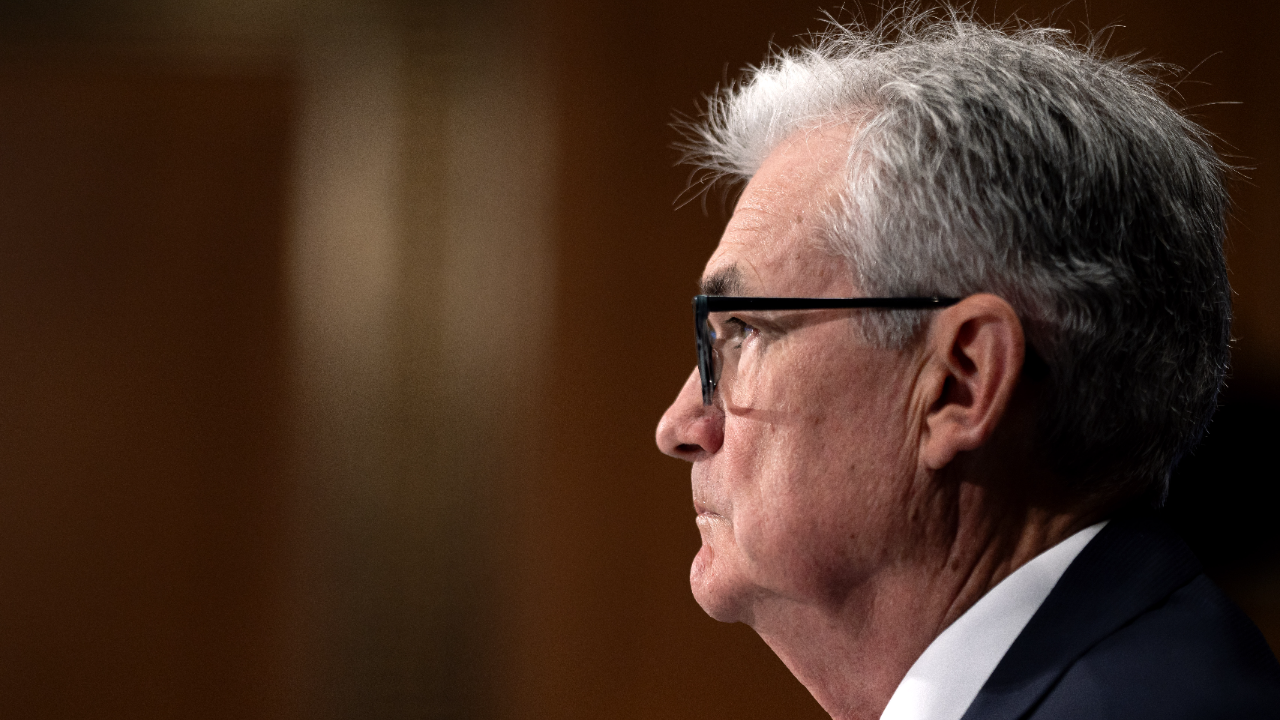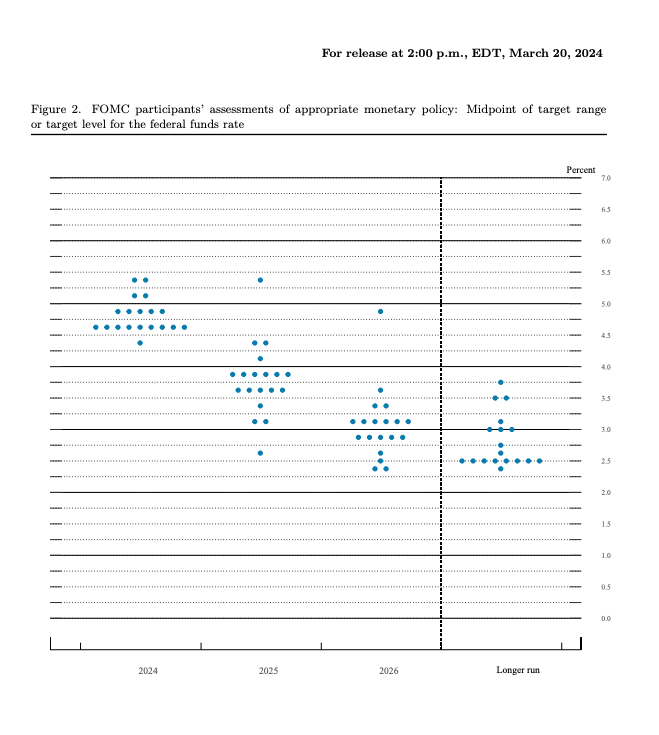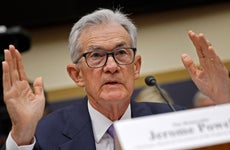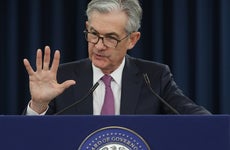The Federal Reserve’s latest dot plot, explained – and what it says about interest rates

The Bankrate promise
At Bankrate we strive to help you make smarter financial decisions. While we adhere to strict , this post may contain references to products from our partners. Here's an explanation for .
Key takeaways
- The Fed’s dot plot is a chart that records each Fed official’s projection for the central bank’s key short-term interest rate.
- The dot plot is updated every three months and is meant to provide insight into the Fed’s future rate decisions, with the caveat that Fed officials can't always predict the future.
- Officials signaled in their latest projections that they see 0.75 percentage point worth of cuts in 2024.
After the Federal Reserve’s latest interest rate decision, you may be tempted to try and start connecting some dots.
That’s because U.S. central bankers updated their closely scrutinized “Summary of Economic Projections” (SEP) at their March meeting, which includes a chart that many Fed watchers obsess over: the “dot plot.” This graphic indicates to consumers where each Fed official sees interest rates rising — or falling — in the future, currently through 2026.
Officials signaled in those updated projections that they see 0.75 percentage point worth of cuts in 2024 on the expectation that inflation and growth will gradually continue slowing. Those moves imply three quarter-point cuts to the Fed’s key interest rate.
Even with three rate cuts next year, the Fed’s key benchmark borrowing rate would stay at the highest level since 2007. Those estimates signal policymakers are prepared to keep rates higher for longer, decisions that could greatly impact consumers’ finances. Higher rates translate to higher yields at banks, along with more expensive borrowing costs on any type of product, from a credit card to a home equity loan.
But even though it seems comparable to getting a sneak peek at the winning lottery numbers — helping you predict when could be a good time to lock in a certificate of deposit (CD) or auto loan — you should still proceed with caution. Many experts, including members of the Fed itself, have questioned the predictive power of this tool. Fed officials’ projections are never set in stone, and they could continue to evolve as more information about inflation and the labor market comes in.
Here’s everything you need to know about the dot plot, including what it is, how to read it — and why you might want to think critically about it.
What is the Fed’s dot plot?
The Fed’s dot plot is a chart updated quarterly that records each Fed official’s projection for the central bank’s key short-term interest rate, the federal funds rate. The dots reflect what each U.S. central banker thinks will be the appropriate midpoint of the fed funds rate at the end of each calendar year.
The Fed usually updates its projections at the end of each quarter, starting in March, followed by June, September and then December. The Fed’s March and June projections extend through the next two years, while the Fed begins estimating rates out into a third year in its September and December updates.
Officials also provide a dot for the longer run, which represents the so-called “neutral rate of interest,” or the point where rates are neither stimulating nor restricting economic growth.
When the U.S. economy looks extraordinarily uncertain, however, officials may choose not to publish new projections. Officials in March 2020, for example, didn’t update their rate estimates at their usual cadence because the pandemic’s impact seemed unknowable.
Each dot represents one Fed official — from Fed Chair Jerome Powell and Vice Chair for Supervision Michael Barr, to New York Fed President John Williams and Chicago Fed President Austan Goolsbee. When the Fed is fully staffed, the dot plot has 19 individual projections. Of course, it’s all kept anonymous, and no one knows which official is which dot.
On the Y-axis is the fed funds rate, and on the X-axis is the year for which officials gave their forecast.
Key benefits of reading the Fed’s dot plot

For example, the Fed’s latest projections show that just two officials see borrowing costs holding steady this year. Most officials expect rate cuts.
Two officials see one quarter-point rate cut in 2024, and five officials see two cuts. Meanwhile, nine officials see three rate cuts next year, marking the median estimate among policymakers. Most Fed watchers focus on the Fed’s median dot as the Federal Open Market Committee (FOMC)’s baseline projection.
The Fed’s dots can also give a glimpse into how officials are reacting to incoming data, as it comes in. The last time policymakers updated their projections, for instance, four officials estimated four cuts, while one official saw six reductions. In March, just one official sees four cuts — and not a single policymaker projects six cuts anymore.
It may sound daunting, but consumers can use it to help guide their financial decisions. Say you’re wondering when to lock in a CD, and you want to snag a bank’s highest offer. You may be able to glean whether rates have already peaked just by looking at the Fed’s projections.
What the Fed’s projections say about inflation, the job market and the economy
The Fed’s SEP doesn’t just clue market participants into what Fed officials are expecting to do with interest rates. It also foreshadows a baseline estimate of what Fed officials expect for the economy.
The Fed uses the Department of Commerce’s personal consumption expenditures (PCE) index to determine just how much higher prices are than its 2 percent target. Their preferred gauge is expected to rise by 2.4 percent in the fourth quarter of 2024 from a year ago, matching last quarter’s estimates, the Fed’s new projections show. Excluding food and energy, meanwhile, “core” prices could reach a hotter 2.6 percent in 2024, up from last quarter’s 2.4 percent projection.
Those projections suggest only slight improvement. Based on the latest data from January, prices have risen 2.4 percent from a year ago and a hotter 2.8 percent when excluding food and energy, Commerce Department data shows.
Meanwhile, the unemployment rate is expected to hit 4 percent in 2024, up only slightly from February’s level of 3.9 percent.
The downside of the Fed’s dot plot
But there are obvious caveats. For starters, the future never evolves exactly as the Fed expects. Case in point: The Fed in December 2021 penciled in a 0.75-1 percent target range for its key benchmark rate by the end of 2022. Rates would end up soaring to 4.25-4.5 percent.
The further out into the future officials go, the harder it also becomes for them to predict what’s going to happen to the U.S. economy. In December 2020, when the U.S. economy was still deep in the trench of the coronavirus pandemic-induced recession and before inflation became a clear threat, most officials saw rates holding at near-zero percent through the end of 2023.
Not to mention, policymakers never penciled in projections for a rock bottom 0-0.25 percent interest rate for 2020 when they updated their forecasts in December 2019 — simply because they’d never imagined that a global pandemic could send the economy into shock.
“You have to remember with the dot plot that this is, in many ways, officials’ base case scenario — if everything unfolds the way they expect,” says Sarah House, managing director and senior economist at Wells Fargo. “More than anything, it’s changing very rapidly.”
Why the dot plot was created
Fed officials started using the dot plot in 2012 at a time when the economy was still recovering from the Great Recession and when interest rates were still near zero.
It was a form of “aggressive forward guidance,” a concept that former Chairman Ben Bernanke created to prepare markets for the Fed’s movement away from the unconventional support measures it introduced to keep the economy afloat, according to Ryan Sweet, chief economist at Oxford Economics.
The tool recognizes just how powerful Fed communication can be at guiding economic activity. If the Fed has properly foreshadowed its rate plans, financial markets will have already priced in a move by the time it actually happens, impacting the borrowing costs that consumers pay. In other words, rates don’t have to wait for the Fed to start moving up.
Take mortgage rates, for example. The average 30-year fixed-rate mortgage was 3.28 percent when the Fed officially signaled in its December 2021 dot plot that it planned to raise interest rates in the upcoming year. But by the time the Fed officially followed through with that rate hike, the average rate had already jumped 1.14 percentage points to 4.4 percent, Bankrate data shows. That coincided with a rapid run-up in the 10-year Treasury yield, as financial markets began pricing in the prospect of hotter inflation and higher rates.
Why you might not want to place too much focus on the dot plot as the Fed fights inflation
Powell himself has questioned the usefulness of his committee’s dots. In the footnotes of a quippy 2019 congressional testimony, Powell included a photo of Seurat’s famous “A Sunday Afternoon on the Island of La Grande Jatte” painting that was so zoomed in, it became distorted.
“As you can see, if you are too focused on a few dots, you may miss the larger picture,” he said, demonstrating what he called a “cautionary tale” about reading the Fed’s dot plots as gospel.
The stakes of misinterpreting the Fed’s rate plans may be even greater this time around. The economy — and more specifically inflation — is guiding the Fed’s interest rate decisions. Whether the Fed cuts interest rates this year depends on whether price pressures cool as much as policymakers expect.
Powell has repeated that officials want to have flexibility, being “data-dependent” and responding to new information as it comes in. But being highly reactionary means forecasts will likely change, possibly meaning each dot has a quick expiration date.
“To be more data dependent, the Fed needs a lot of flexibility,” Sweet says. “The dot plot isn’t a forecast. It’s not a commitment. Interest rate projections change as the economy changes, as developments in financial markets change. The dot plot gets dated pretty quickly.”
Powell said in a March 2019 address that the chart “can be a constructive element of comprehensive policy communication” if it’s properly understood.
The dot plot increases transparency over Fed operations, according to Julia Coronado, president and founder of MacroPolicy Perspectives, who used to work for the Fed’s board of governors.
“The Fed feels like it really does need to explain and justify why it’s doing what it’s doing,” Coronado says. “But that doesn’t mean it’s useful for the public or for markets. It can be confusing, and it can be misleading.”
The public also has a chance to see the full range of views on the FOMC. Regional presidents who don’t have a vote, for example, can still input their rate projections. But that can often mean there’s more noise than signal. Each dot reflects a rate move the committee hasn’t come to a consensus on, and every policymaker could have a different baseline forecast that led them to that assumption.
“Is that really conveying useful information? That’s very debatable,” says Jonathan Wright, professor of economics at Johns Hopkins University. “Some people think it just creates confusion or a mixed signal.”
Related Articles



The Federal Reserve’s board of governors, explained — who’s on it and what they do

Fed leaves interest rates unchanged, signals openness to future cuts